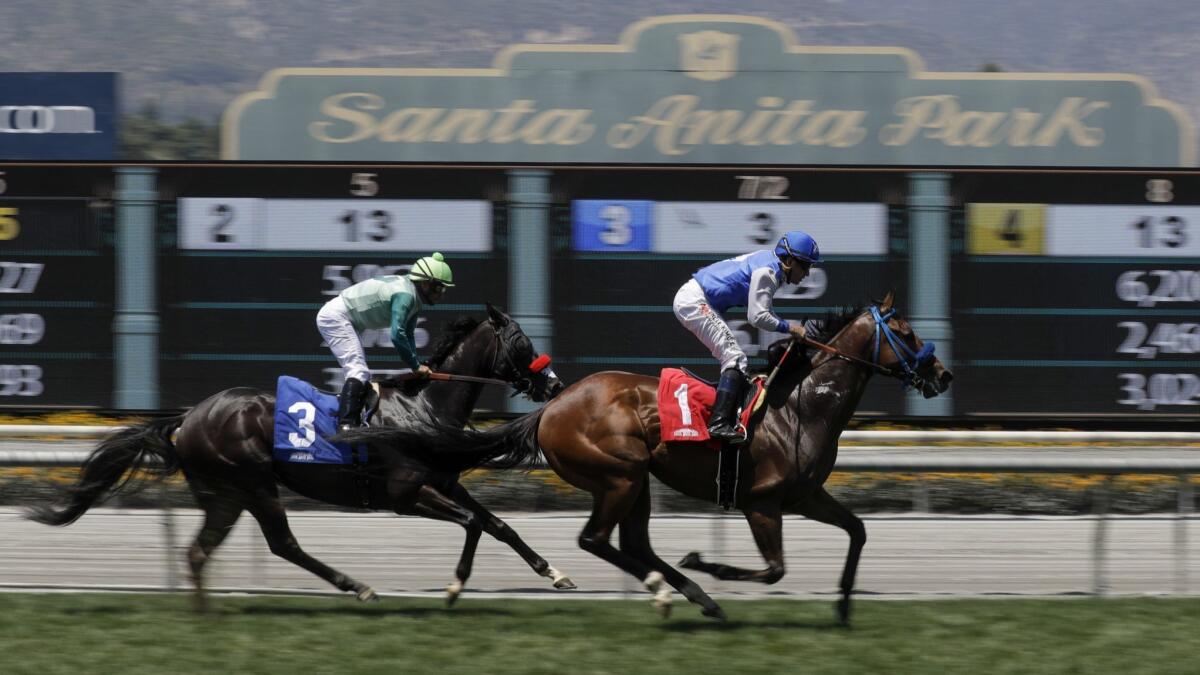Special Report: Statistics might not tell the whole story about horse racing deaths

- Share via
There’s an expression popularized by Mark Twain that there are three kinds of lies: lies, damned lies and statistics.
It’s upon that premise that the public should be cautiously viewing one of the battle fronts on the future of horse racing: the counting of the equine dead. On the surface, it should be simple. But, with so much at stake, according to industry leaders, the need for accurate reporting and analysis has never been greater.
“These metrics are more important than they’ve ever been,” said Alan Balch, executive director of the California Thoroughbred Trainers. “But they need to be right and they need to be understood properly. They all need to be put in context, refined, improved, clarified, expanded and capable of explanation. ”
Santa Anita recently put out its closing statement on its winter/spring meeting, lauding its improvements through statistics. It implied that midseason reforms were the impetus behind safer racing, using phrases such as “since the new rules took effect in the middle of March …”
However, many of the reforms, such as the reduction in race-day Lasix, a medication used to ease bleeding from the lungs, have scientifically been proven as having no effect on catastrophic injuries.
— The release cited a 58% reduction in racing fatalities after reforms were instituted. Before the track was shut down, it had 4.40 deaths per 1,000 starts through 40 cards and 2,725 starters, information not contained in the release.
— It cited a death rate of 1.86 since the reforms, but did not mentionthat is still above the national average of 1.68 and more than double that of Del Mar last year (0.79) and significantly worse than Los Alamitos last year (1.06). It also didn’t mention other mitigating factors such as fixes to the racing surfaces and better weather, both unrelated to reforms.
— It cited a training statistic of .019, which is a metric that doesn’t exist in racing. It includes gallops, which are not counted and is nothing more than a guess.
The bending of statistics also exists on the side of those seeking the extinction of horse racing. Some animal rights’ groups question official state figures, claiming the deaths of horses with non-exercise-related conditions, which can include laminitis and horses hitting their heads after flipping over in their stall, as ways of bolstering their arguments. Some figures cited offer no explanation or sourcing other than saying that tracks are hiding or covering up deaths.
All of which show that statistics seem to be a pawn in this war of perspectives.
At the center of the national counting is the Jockey Club’s Equine Injury Database (EID), a scientific accounting storehouse that by its own admission tells only half the story. Deaths that occur in morning workouts and training are not counted.
Dr. Tim Parkin, a veterinary epidemiologist at the University of Glasgow in Scotland, is the chief researcher for the database. He would like to add workout data but admits it brings with it a series of challenges.
“Our models would be more predictive if we included workout data,” Parkin said. “But trying to understand the risk of a morning workout would be a depth of analysis that would not compare to the racing model. It would be two separate models.
“You would have to record not only the workout, but the distance and the intensity of the workout and other factors that could be different from racing.”
Craig Fravel, a former Del Mar executive and current president and chief executive of the Breeders’ Cup, sees things headed the way of more complete reporting.
“Over time we need to evolve that way,” Fravel said. “It’s a much different world now. In California there is a lot more training over tracks that are being raced on. In other countries it’s a lot more spread out. It’s a lot more complicated to make sure there are regulatory vets on site for accuracy. It’s not as simple as it might sound.”
The number of deaths associated with Santa Anita at its recent meet is 30, but as far as the EID is concerned it’s 17, because that is the number of horses that died during racing.
California, along with New York, is one of the most transparent states when it comes to the reporting of deaths.
“California has always had a fatality reporting monitoring system,” said Dr. Rick Arthur, chief equine medical director for the California Horse Racing Board. “We have a very robust accounting system, where we include colic, ponies [the horses that lead race horses to the track], those that ship in and are injured in the van and end up being euthanized when they stop at a track.”
The rules that the EID use is to count any horse that dies within 72 hours of running.
Under those rules, Barbaro, whose fight for survival over several months after being injured in the 2006 Preakness, would not have been a racing death.
“When Barbaro was injured I started getting calls from local and national media about if this was unusual and what would be the outcome,” said Dr. Mary Scollay, for a few more weeks the equine medical director for Kentucky before becoming executive director of the Racing Medication and Testing Consortium (RMTC) in August.
“I had all these reports but had no answers because everyone kept their own records. Information didn’t transfer, everyone kept their own records. I approached my regulatory colleagues about a national reporting system and the Jockey Club presented interest.”
Sign up for our horse racing newsletter »
Kristin Werner, senior counsel of the Jockey Club, and Matt Iuliano, executive director of the Jockey Club, oversee the database.
“Each year we add a couple of categories of reporting,” Iuliano said of the more than 40 they currently track. “We have a library that creates internal triggers that allows us to look at data and follow up through the charts and video replays. It’s a very thorough system. ‘Vanned off’ [in the charts] is a trigger for Kristin to check against.”
Werner said one of the first things to check is if the horse started again.
“Then we don’t follow up,” Warner said.
Despite the perceived unanimity in the reporting of injuries, there are major holes. Even though more than 110 tracks report to the database, less than a third of them allow their stats to be made public. Every track in California makes its data public on the website except Los Alamitos, whose data can be obtained through the CHRB.
Among those tracks that didn’t make statistics available through the EID website was Churchill Downs, the most recognizable track in the U.S. The Louisville Courier-Journal, through public records requests, confirmed the fatality rate at Churchill Downs last year was 2.73 per 1,000 starts, the highest in the country next to Hawthorne, near Chicago, which had a 2.99. Last year, Santa Anita’s fatality rate was 2.04.
The death rate at the recent Santa Anita meeting was 3.17, and with a successful fall meeting could bring that number lower.
“If the numbers hold, we may have the lowest number of fatalities since 1990,” said the CHRB’s Arthur. “They crammed up all the fatalities at the same time. Then Battle Of Midway” — the 17th fatality at Santa Anita on Feb. 23 — “changed everything. If you deal with numbers, over time there is always a regression toward the mean.”
The national average of 1.68 per 1,000 starts is on the decline but still not acceptable.
“The 1.68 as an average is not a desirable term,” Scollay said. “How would you like it if I said, ‘I had an average time at your party.’ ‘Gee, thanks.’ That’s a C grade. We should be striving for much more than that.”
Balch, of the California Thoroughbred Trainers, still believes there needs to be a better classification of fatalities.
“We need to know when there are accidents,” Balch said. “It’s a different circumstance if two horses collide. It’s different if horses clipped heels. The implication is there is something wrong with the race track or training, but that’s not always the case. Accidents are getting into epidemiology. In the bigger picture, yes, a horse has died, which is bad, but the stats need to be refined.”
Scollay agrees that the statistics need some work.
“From a public perception, a dead horse is a dead horse and that’s not acceptable,” Scollay said. “At the end of the day there are sudden deaths unrelated to racing. A horse can have a heart attack, and the necropsy can’t diagnose an arrythmia. There is always the opportunity for fatal events not related to racing. Pneumonia is completely unrelated to exercise. Race-related data is pretty easy. If we were to expand to training stuff, we would be susceptible to inconsistencies.”
Parkin says through the database they are able to explain about 35% of fatality trends.
“We know race distance is a factor, staying with the same trainer is a good thing, more horses starting at 2 years old is a good thing,” said EID’s chief researcher. “Intact [non-gelded] males have a slightly elevated risk. Putting all these things together has contributed to a four to eight percent reduction in risk.”
More to Read
Go beyond the scoreboard
Get the latest on L.A.'s teams in the daily Sports Report newsletter.
You may occasionally receive promotional content from the Los Angeles Times.











